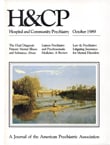Assessment and Classification of Patients With Psychiatric and Substance Abuse Syndromes
Abstract
Patients with both mental illness and substance abuse pose a major clinical challenge to mental health and substance abuse clinicians. The literature seems to support the hypothesis that mental illness and substance abuse occur together more frequently than chance would predict. Assessment and classification of these patients should be guided by clinicians' needs to make meaningful therapeutic judgments and to communicate effectively with each other in coordinating treatment. Different phases of treatment require different approaches to assessment and classification. In initial classification, the clinician should recognize the problem of dual diagnosis and resist premature assumptions about which diagnosis is primary. Long-term treatment and rehabilitation may require systematic evaluation of alternative clinical by potbeses about why a patient exhibits both disorders. This approach eventually may lead to better ways to assess, classify, and treat these difficult patients.
Access content
To read the fulltext, please use one of the options below to sign in or purchase access.- Personal login
- Institutional Login
- Sign in via OpenAthens
- Register for access
-
Please login/register if you wish to pair your device and check access availability.
Not a subscriber?
PsychiatryOnline subscription options offer access to the DSM-5 library, books, journals, CME, and patient resources. This all-in-one virtual library provides psychiatrists and mental health professionals with key resources for diagnosis, treatment, research, and professional development.
Need more help? PsychiatryOnline Customer Service may be reached by emailing [email protected] or by calling 800-368-5777 (in the U.S.) or 703-907-7322 (outside the U.S.).



